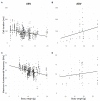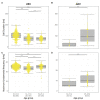Encoding of Arousal and Physical Characteristics in Audible and Ultrasonic Vocalizations of Mongolian Gerbil Pups Testing Common Rules for Mammals
- PMID: 37627344
- PMCID: PMC10451175
- DOI: 10.3390/ani13162553
Encoding of Arousal and Physical Characteristics in Audible and Ultrasonic Vocalizations of Mongolian Gerbil Pups Testing Common Rules for Mammals
Abstract
In mammals, common rules for the encoding of arousal and physical characteristics of the sender are suggested based on a similar vocal production apparatus. In this study, we want to investigate to what extent vocalizations of developing Mongolian gerbil pups fulfill these rules. We recorded vocalizations of 28 Mongolian gerbil pups in four developmental stages using a separation paradigm, suggested to induce different arousal levels. For low arousal, a pup was placed in an arena isolated from its siblings and parents; for high arousal, the pup was additionally stressed through the simulation of a predator. An unsupervised cluster analysis revealed three call types: ultrasonic (USV), audible vocalizations (ADV), and transitions between both (USV-ADV). The USV and USV-ADV rate showed an age-dependent decrease, contrasting an age-dependent increase for ADVs. Vocal correlates for the encoding of arousal were found for USVs and of physical characteristics for USVs and ADVs. However, the pattern of encoding these cues differed between call types and only partly confirmed the common rules suggested for mammals. Our results show that divergent encoding patterns do not only differ between species but also between call types within a species, indicating that coding rules can be shaped by socio-ecological factors or call type specific production mechanisms.
Keywords: age; arousal; audible vocalizations; body weight; development; individual signatures; mammal; sex; ultrasonic vocalizations; vocal ontogeny.
Conflict of interest statement
The authors declare no conflict of interest.
Figures







Similar articles
-
Unsupervised discovery of family specific vocal usage in the Mongolian gerbil.Elife. 2024 Dec 16;12:RP89892. doi: 10.7554/eLife.89892. Elife. 2024. PMID: 39680425 Free PMC article.
-
Selection on ultrasonic call rate in neonatal rats affects low frequency, but not ultrasonic, vocalizations in adults.Ethology. 2020 Nov;126(11):1007-1018. doi: 10.1111/eth.13075. Epub 2020 Jun 23. Ethology. 2020. PMID: 39027033 Free PMC article.
-
Rates of ultrasonic vocalizations are more strongly related than acoustic features to non-vocal behaviors in mouse pups.Front Behav Neurosci. 2022 Dec 19;16:1015484. doi: 10.3389/fnbeh.2022.1015484. eCollection 2022. Front Behav Neurosci. 2022. PMID: 36600992 Free PMC article.
-
Infant rodent ultrasounds -- a gate to the understanding of sound communication.Behav Genet. 2005 Jan;35(1):19-29. doi: 10.1007/s10519-004-0853-8. Behav Genet. 2005. PMID: 15674530 Review.
-
Biological Functions of Rat Ultrasonic Vocalizations, Arousal Mechanisms, and Call Initiation.Brain Sci. 2021 May 9;11(5):605. doi: 10.3390/brainsci11050605. Brain Sci. 2021. PMID: 34065107 Free PMC article. Review.
Cited by
-
Graded calls of the smallest terrestrial mammal, the Etruscan shrew, living in a closed habitat.iScience. 2024 Nov 1;27(12):111297. doi: 10.1016/j.isci.2024.111297. eCollection 2024 Dec 20. iScience. 2024. PMID: 39628566 Free PMC article.
-
Unsupervised discovery of family specific vocal usage in the Mongolian gerbil.bioRxiv [Preprint]. 2024 Sep 4:2023.03.11.532197. doi: 10.1101/2023.03.11.532197. bioRxiv. 2024. Update in: Elife. 2024 Dec 16;12:RP89892. doi: 10.7554/eLife.89892. PMID: 39282260 Free PMC article. Updated. Preprint.
-
Unsupervised discovery of family specific vocal usage in the Mongolian gerbil.Elife. 2024 Dec 16;12:RP89892. doi: 10.7554/eLife.89892. Elife. 2024. PMID: 39680425 Free PMC article.
References
-
- Lieberman P., Blumstein S.E. Speech Physiology, Speech Perception, and Acoustic Phonetics. Cambridge University Press; Cambridge, MA, USA: 1988.
-
- Briefer E.F. Vocal Expression of Emotions in Mammals: Mechanisms of Production and Evidence. J. Zool. 2012;288:1–20. doi: 10.1111/j.1469-7998.2012.00920.x. - DOI
-
- Briefer E.F. Coding for ‘Dynamic’ Information: Vocal Expression of Emotional Arousal and Valence in Non-Human Animals. In: Aubin T., Mathevon N., editors. Coding Strategies in Vertebrate Acoustic Communication. Animal Signals and Communication. Springer; Cham, Switzerland: 2020.
-
- Charlton B.D., Pisanski K., Raine J., Reby D. Coding of Static Information in Terrestrial Mammal Vocal Signals. In: Aubin T., Mathevon N., editors. Coding Strategies in Vertebrate Acoustic Communication. Animal Signals and Communication. Springer; Cham, Switzerland: 2020.
LinkOut - more resources
Full Text Sources
Miscellaneous

